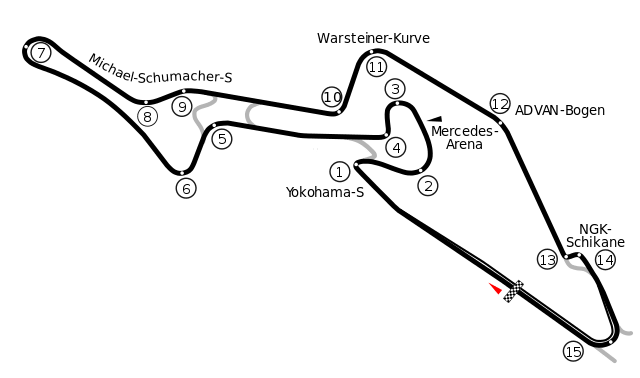
Formula 1 Aramco Grosser Preis Der Eifel 2020, the 2020 Eifel Grand Prix, which takes place over 60 laps of the 5.148-kilometre Nurburgring, former host of the German Grand Prix, on Sunday, October 11th.
The Nürburgring is a 150,000 person capacity motorsports complex located in the town of Nürburg, Rhineland-Palatinate, Germany. It features a Grand Prix race track built in 1984, and a much longer Nordschleife "North loop" track which was built in the 1920s around the village and medieval castle of Nürburg in the Eifel mountains. The north loop is 20.8 km (12.9 mi) long and has more than 300 metres (1,000 feet) of elevation change from its lowest to highest points. Jackie Stewart nicknamed the old track "The Green Hell".
Originally, the track featured four configurations: the 28.265 km (17.563 mi)-long Gesamtstrecke ("Whole Course"), which in turn consisted of the 22.810 km (14.173 mi) Nordschleife ("North Loop"), and the 7.747 km (4.814 mi) Südschleife ("South Loop"). There also was a 2.281 km (1.417 mi) warm-up loop called Zielschleife ("Finish Loop") or Betonschleife ("Concrete Loop"), around the pit area.
In 1907, the first Eifelrennen race was held on the one-off Taunus circuit, a 117 km (73 mi) made up of public roads starting between the towns of Wehrleim and Saalburg just north of Frankfurt. In the early 1920s, ADAC Eifelrennen races were held on the twisty 33.2 km (20.6 mi) Nideggen public road circuit near Cologne and Bonn. Sometime around 1925, the construction of a dedicated race track was proposed just south of the Nideggen circuit around the ancient castle of the town of Nürburg, following the examples of Italy's Monza and Targa Florio courses, and Berlin's AVUS, yet with a different character. The layout of the circuit in the mountains was similar to the Targa Florio event, one of the most important motor races at that time. The original Nürburgring was to be a showcase for German automotive engineering and racing talent. Construction of the track, designed by the Eichler Architekturbüro from Ravensburg (led by architect Gustav Eichler), began in October 1925.
The track was completed in spring of 1927, and the ADAC Eifelrennen races were continued there. The first races to take place on 18 June 1927 showed motorcycles and sidecars. The first motorcycle race was won by Toni Ulmen on an English 350 cc Velocette. The cars followed a day later, and Rudolf Caracciola was the winner of the over 5000 cc class in a Mercedes-Benz Compressor. In addition, the track was opened to the public in the evenings and on weekends, as a one-way toll road.[3] The whole track consisted of 174 bends (prior to 1971 changes), and averaged 8 to 9 metres (26 to 30 ft) in width. The fastest time ever around the full Gesamtstrecke was by Louis Chiron, at an average speed of 112.31 km/h (72 mph) in his Bugatti.
The big, scary Nordschleife version of the Nurburgring was completed in 1927. But after eventually proving too big and too scary for F1, Niki Lauda’s 1976 horror crash in the German Grand Prix forced a re-think, with the more manageable, more modern Grand Prix circuit opened in 1984, with a star-studded roll-call of F1 drivers – including Ayrton Senna, James Hunt, Lauda and Stirling Moss – racing around the track in Mercedes 190 saloon cars to mark the occasion. The track was completed in spring of 1927, and the ADAC Eifelrennen races were continued there. The first races to take place on 18 June 1927 showed motorcycles and sidecars. The first motorcycle race was won by Toni Ulmen on an English 350 cc Velocette. The cars followed a day later, and Rudolf Caracciola was the winner of the over 5000 cc class in a Mercedes-Benz Compressor. In addition, the track was opened to the public in the evenings and on weekends, as a one-way toll road.[3] The whole track consisted of 174 bends (prior to 1971 changes), and averaged 8 to 9 metres (26 to 30 ft) in width. The fastest time ever around the full Gesamtstrecke was by Louis Chiron, at an average speed of 112.31 km/h (72 mph) in his Bugatti.
The modern circuit got off the mark with the 1984 European Grand Prix and the 1985 German Grand Prix. Falling off the calendar until 1995, it then hosted various races in German, European and Luxembourg Grand Prix guise – up until 2013, before its 2020 return. The Nordschleife it ain’t – but then that’s probably for the best. The modern circuit utilises the start-finish straight of the old Sudschleife track, before the drivers then tackle the tight right-hander at Turn 1 (Haug-Haken) and go on an enjoyable high-speed plunge down to the Dunlop-Kehre hairpin. From there, the track shoots back uphill, with some fantastic high-speed corners leading back to the slow, Hungaroring-esque right-hander that ends the lap.
1:29.468 (2004)
1:35:49.641
+4.470s
+14.613s
1:25.269
1:25.525
1:25.562
1:33:38.992
+1.008s
+5.830s
1:29.398
1:29.501
1:29.608
| Driver | Points |
|---|---|
Lewis Hamilton | 347 |
Valtteri Bottas | 223 |
Max Verstappen | 214 |
Sergio Perez | 125 |
Daniel Ricciardo | 119 |
Carlos Sainz | 105 |
Alexander Albon | 105 |
Charles Leclerc | 98 |
Lando Norris | 97 |
Pierre Gasly | 74 |
| Team | Points |
|---|---|
Mercedes | 573 |
Red Bull | 319 |
McLaren | 202 |
Racing Point | 195 |
Renault | 181 |
Ferrari | 131 |
AlphaTauri | 107 |
Alfa Romeo | 8 |
Haas | 3 |
Williams | 0 |